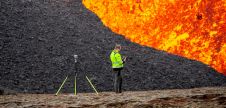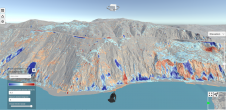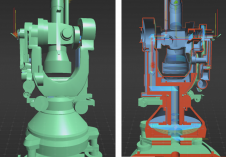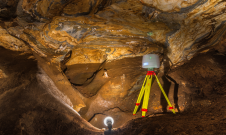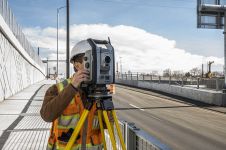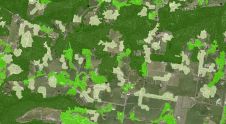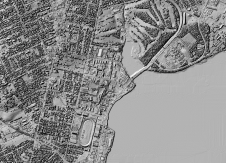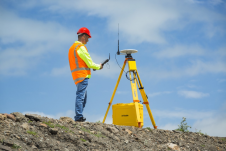OS Net - Preparations for Future GNSS
This article was originally published inGeomatics World。
Ordnance Survey (OS) has just updated its geodetic infrastructure. Mark Greaves, Lead Consultant at Geodesy, describes these developments and takes a look at shorter and longer-term geodetic issues for surveyors.
OS Net is Ordnance Survey's national network of over 110 permanent, geodetic quality, GNSS stations. GNSS observation data is streamed in real-time to a central hub and access to the national standard realisation of ETRS89 is enabled through the following services:
- Real-time GNSS correction services available to customers of OS Net commercial partners.
- Real-time GNSS correction services for OS surveyors.
- 高率(即1Hz)Rinex数据用于商业GNSS定位操作(例如空气寄生遥感)。
- Publicly available, free of charge OS Net station RINEX data via the OS website.
- Long term archive of OS Net GNSS data at the Natural Environment Research Council (NERC) funded British Isles continuous GNSS Facility (BIGF) hosted at the University of Nottingham.
New OS Net Receivers
Like all national GNSS networks it is important that OS Net keeps pace with developments in GNSS systems and signals. To this end, the entire OS Net receiver stock has recently been updated with brand new receivers.
以前的接收器是九岁的,经过长时间的恒定(请记住,该设备运行24x7x365)和可靠的服务开始生命的尽头。此外,尽管旧的接收器(和天线都没有改变)具有多构造功能,但接收器固件和OS Net Control软件的不同升级路径和时间表意味着只能从GPS和GLONASS中流式传输和提供数据。
RTCM MSM(多个信号消息)数据传输格式的出现意味着现在更容易处理可用的观测值数量。这包括来自欧洲伽利略和中国贝杜系统的数据。
准备新信号
The upgraded OS Net is not only ready for Galileo and Beidou but also the newer GPS signals L2C and L5. Although not being tracked at the moment, the network is also ready for GLONASS L3. The L3 GLONASS signal is the start of a move away from the FDMA (Frequency-division multiple access) technique to the CDMA (Code-division multiple access) technique used by all the other GNSS systems. The original FDMA signals will continue for the foreseeable future but will be augmented by new CDMA signals.
50/50 Hardware Split
旧的操作系统净接收器被几乎所有的歌唱le make and model. For the refresh, the network is split approximately 50/50 across two different makes of receiver which will be located evenly across the country. Additionally, there are a small number of a third make of receiver. The reason behind the mix of receiver manufacturers is to mitigate against the very rare situation where an undiagnosed firmware problem can cause all the receivers of a particular make/model to fail at the same time. Whilst these events are thankfully very rare, the impact across an entire national GNSS network can be very serious indeed since the potential is for the whole network to be non-functional until the problem is fixed.
Previous problems that unexpectedly triggered a failure of all receivers have been caused by such things as a GPS week number roll over not being handled correctly in the firmware. See ‘GPS Rollover Week’ box out.
Accessing New Signals
OS Net users will access the new signals either through the RTK correction service they are subscribed to or via the free OS Net RINEX data from the OS website -www.ordnancesurvey.co.uk/gps/os-net-rinex-data/。当前网站以Rinex V2格式提供GPS+GLONASS数据文件。这不会改变。最初,将通过手动下载提供Rinex V3格式的新数据文件,其中包含GPS+Glonass+Galileo+Beidou数据。当前的手册下载目录是www.ordnancesurvey.co.uk/gps/rinex。Longer term, the RINEX ordering process will be modified to allow users to select data delivery in RINEX v2 (GPS+GLO) or RINEX v3 (GPS+GLO+GAL+BDS) formats.
All these new signals can only mean better and more robust positioning for users, especially in harsh ‘urban canyons’. Outside of the surveying world, the convergence of new signals and services and improved user devices means accurate (sub metre) and low cost positioning for a much larger group of users. For example the Galileo Commercial Service, which now looks like it will be free of charge (http://insidegnss.com/fundamental-rethink-for-galileo-commercial-service/), could offer decimetre positioning on low cost devices without the need for an additional correction signal. The future is not just about new signals.
Dealing with Drift
从新信号和星座定位的改进以及设备变得更好,这意味着这种“未来的GNSS”在更新国家GNSS CORS网络的需求之外还具有其他影响。这些影响之一是更多用户意识到用于映射和定位的固定参考帧之间的漂移,例如欧洲的ETRS89,以及其定位设备使用的4D WGS84参考框架。
事实是,世界不断在构造板上转移,但是地图(及其用户)像固定的坐标一样,这些坐标不会改变。在GNSS之前,这很容易实现,因为大多数定位和映射都是从调整到特定国家 /地区的坐标参考系统中的固定地面创建的。例如,在英国,我们的固定点过去曾经包括非常熟悉的触发支柱,我们有一个称为OSGB36国家电网的映射坐标参考系统,该系统与我们的地球一点点紧密合适。构造板移动对映射坐标或固定点几乎没有影响,因为它们都以“一个”而移动,并且网络通常保持相同的形状。
GNSS require a coordinate reference system that has a good average fit to the whole Earth and also has to change to keep up with the shifting of tectonic plates – it is effectively 4D (3D + time). The GPS coordinate reference system is WGS84 and it is perfect for GPS but perhaps not ideal for large- or mid-scale mapping because it moves, albeit slowly and in a predictable way.
Europe’s GNSS compatible datum, ETRS89, is fixed to the European tectonic plate. It was aligned to WGS84 on 1 January 1989 and moves by around 2.5cm each year. In theory, coordinates derived directly from GNSS without additional correction from, for example, OS Net, are now about 72cm away from where they should be in the ETRS89 system. However, for most consumer users the 72cm difference is swamped by the accuracy limits of their receiver (phone, satnav etc) which are only accurate to within a few metres. So, the difference is not noticeable if you’re out walking, or driving around the country. Professional users, such as surveyors making use of an OS Net derived RTK correction service, are automatically positioned in ETRS89 so the drift is accounted for.
漂移以恒定的速度发生,但是在“伪造者”和消费者级别的GNS和接收器中,在未来几年内变得越来越准确,因此,大量用户可能会变得更加明显。
Future Options
There are a number of options to deal with this in the future:
- Mapping in each country could stay on a local system such as OSGB36, then an additional transformation could be employed to first go from WGS84 to ETRS89 and then on to OSGB36.
- 所有映射都可以基于ETRS89,并且只需保持时间发展WGS84/ETRS89转换的时间即可。
- Adopt a version of ETRS89 with a more current time stamp (e.g. ETRS2030) and have coordinate jumps every few decades to keep up with dynamic GNSS reference frames (i.e. if the ETRSyyyy / WGS84 difference were to be kept at less than 1m, a coordinate jump would be required approximately every 40 years.)
- Alternatively have a dynamic “4D” coordinate system that constantly evolves like WGS84 and users become used to all coordinates and map data having a time stamp plus the availability of a transformation to bring coordinates into a common time frame if so desired.
Ordnance Survey, and other mapping agencies in Europe, are planning for the future when this becomes an issue and will be considering, in consultation with users, the best way to deal with it.
OS Geodetic Strategy
Regarding not just the future of OS Net and coordinate reference frames but OS’s wider geodetic future for Great Britain – a new strategy will be published soon for consultation with users. It will set out Ordnance Survey’s Geodetic & Positioning Services policy and activity plans through the next few years. It will describe OS’s current core policies for services in the field of national geodesy and positioning and a number of strategic aims for future work and consultations.
This article was published in Geomatics World September/October 2018
------------------------------
GPS Rollover Week
The data field in the GPS signal that holds the current GPS week number is a 10-bit binary number. This limits the range of the week number to between 0 and 1023, or 1024 weeks in total. The next time the counter will reach week 1023 and rollover to zero is on 6 April 2019.
接收器必须使用一周给软木rect date and not one that’s 19.7 years (1024 weeks) adrift. There are various methods of doing this and they commonly involve referencing another date embedded in the receiver firmware. This is the second week number rollover in the life of GPS so receiver manufacturers are better prepared for it this time. So, as long as the receiver firmware is up to date, the week number roll over should not be a problem.
Source:https://spectracom.com/resources/blog/lisa-perdue/2018/gps-2019-week-rollover-what-you-need-know
------------------------------
GNSS星座摘要
测量师现在可以从四个GNSS卫星,GPS,Glonass,Galileo和Beidou的星座中收集数据,总共100多颗卫星。本文总结了每个星座的状态。
GPS
GPS has been upgrading, with additional signals and improvements with each new generation of satellite. Developments with the upcoming Block III satellites include longer design life, better clocks and the installation of laser reflectors. The current state of play is shown in Table 1.
Block |
没有操作卫星 |
C/A code L1 |
P code L1/L2 |
L2C |
L5 |
L1C |
Launch span |
Design Life (yr) |
iia |
1 |
Y |
Y |
N |
N |
N |
7.5 |
|
IIR |
11 |
Y |
Y |
N |
N |
N |
1997-2014 |
7.5 |
IIR-M |
7 |
Y |
Y |
Y |
N |
N |
2005-2009 |
7.5 |
iif |
12 |
Y |
Y |
Y |
Y |
N |
2010-2016 |
12 |
III / IIIF |
0 |
Y |
Y |
Y |
Y |
Y |
从2018年9月开始 |
15 |
Total |
31 |
GPS constellation status.
Glonass
Glonass星座目前包括24个“ M”类和1个K1类卫星。2019年,有计划发射另外四颗K1卫星和一颗K2卫星。这些都将在L1,L2和L3频率上广播FDMA信号和CDMA信号。K2卫星将使用“辐射硬化”的组件,并具有10年的设计寿命。
Galileo
伽利略星座有18个操作卫星,另外四个将于2018年7月25日推出。伽利略广播使用CDMA的四个信号。
Beidou
在2020年完成时,Beidou星座将包括27个中地球轨道(MEO),5个地静止和3个倾斜轨道卫星。该系统自2012年以来一直在SE亚洲提供区域覆盖,现在正在扩展以提供全球服务。
Currently, all geostationary, 8 inclined orbit and 14 MEO satellites, are in operation. A further 1 geostationary and 6 MEO satellites are programmed to be launched this year and possibly four more.
Beidou在四个频段中使用CDMA广播 - E1,E2,E5B和E6与伽利略重叠。
Make your inbox more interesting.添加一些地理。
Keep abreast of news, developments and technological advancement in the geomatics industry.
免费注册




